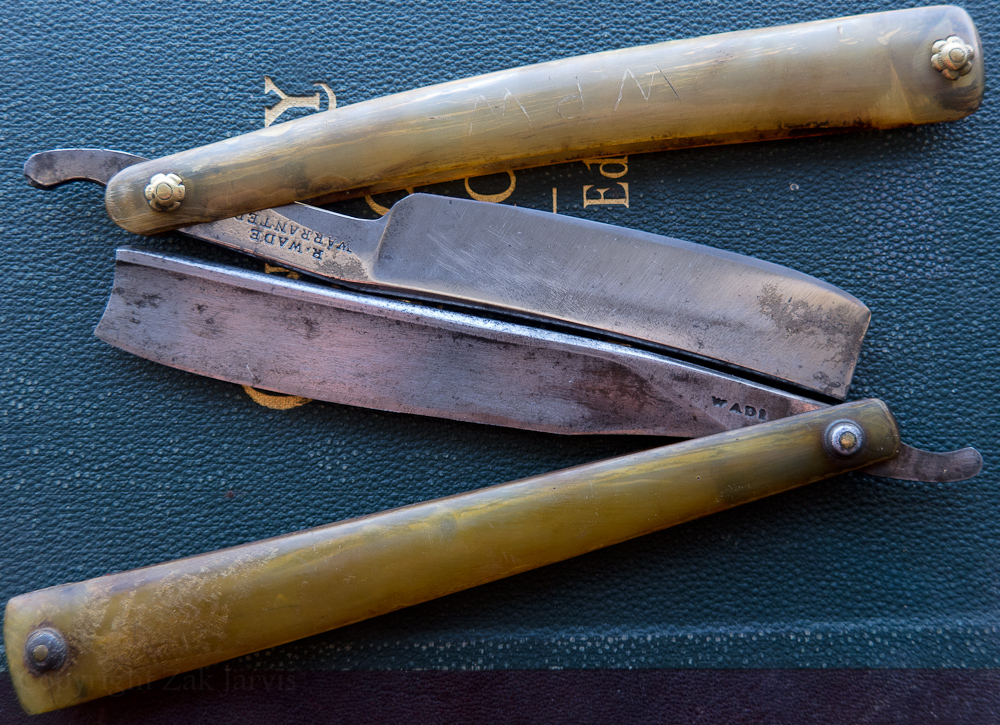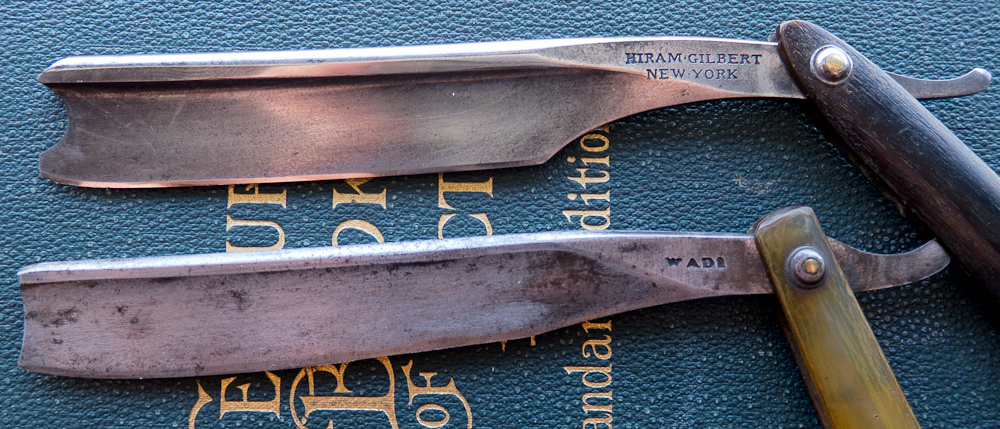Results 1 to 10 of 37
Hybrid View
-
09-20-2012, 12:02 AM #1
 Robert Wade and the challenge of sorting history.
Robert Wade and the challenge of sorting history.

I got this off of eBay because I felt certain, based on the grind of the blade, that it was an late 1820's model and thus made under Robert Wade's name by his widow, Jane.
However Neil Miller wasn't too sure about that dating when I showed it him, and now that I have it in hand, neither am I.

There's absolutely no doubt that it's old. I've seen numerous razors dated to the late 1700's with this basic style and it's a style that clearly continued into the 1810's. Supposedly, Robert Wade began making razors in 1816, but the man is surrounded by mystery and there's very little solid information about him. He died in 1825.

The other Wade stamped razor I have was purchased from Robert Doyle who dated it to roughly 1815. When you see both razors together it really looks like a slam dunk that Doyle was wrong and my new Wade razor is actually the older one. The straight scales, the small shoulderless blade (it's about 4/8), the simplistic stamp, all scream 'old' far louder than the design features of the R. Wade / Warranted blade.

Compare it to this very early Thomas Scargill blade. Note that the scales are very similar (though the Wade razor has a lead wedge and the Scargill does not).
So where's the challenge here? Clearly this Wade razor is from the beginning of Robert Wade's known production, right?

Except, the grind of the blade, with that pronounced lip along the spine, is quite similar to this Hiram Gilbert stamped razor (probably made by Joseph Elliot) in the 1830's. To the best of my knowledge, no one was grinding razors like that in the 1810's.

But the lip isn't that pronounced compared to the Hiram Gilbert. Plus, razors were regularly reground by street vendors who set up foot-powered wheels and offered to clean and fix old razors. Maybe it was reground into the 1830's style?
Or maybe Jane Wade made it herself, desperate for income after the death of her husband, and with only the skills she'd acquired by watching her father or brothers or spouse at work. She continued to produce razors with his stamp for four years before the inevitable caught up to her.
I seriously doubt I'll ever know. But there are some questions that MIGHT help.
Are there other very early razors with a pronounced spine bulge?
Is the lack of a first initial on the stamp any kind of indicator?
Those are things we might be able to find out.-Zak Jarvis. Writer. Artist. Bon vivant.
-
The Following 11 Users Say Thank You to Voidmonster For This Useful Post:
-
09-20-2012, 04:24 AM #2Thread derailment specialist.



- Join Date
- Dec 2011
- Location
- Republica de Tejas
- Posts
- 2,792
Thanked: 884
Good questions and I've no good answers for you.
Fascinating old razor either way.
WMember Tonkin Gulf Yacht Club, participant SE Asia War Games 1972-1973. The oath I swore has no statute of limitation.
-
10-09-2012, 07:42 PM #3Historically Inquisitive



- Join Date
- Aug 2011
- Location
- Upstate New York
- Posts
- 5,782
- Blog Entries
- 1
Thanked: 4249
According to my findings Mrs Wade was listed as a razor maker for about a year before she passed.
"The partnership with Butcher ended. In 1828, only Mrs. Robert Wade was listed as a razor manufacturer in Arundel Street (in one directory, the listed name was Jane Wade). Finally, the local press reported that Mrs. Robert Wade, the relict of Mr. Wade of Arundel Street, had died near Sheffield on 14 July 1829 "(Sheffield Independent, 18 July 1829).
That said perhaps your razor is from her business, would be interesting to find out for sure.Last edited by Martin103; 10-09-2012 at 08:12 PM.
-
The Following User Says Thank You to Martin103 For This Useful Post:
Voidmonster (10-13-2012)
-
10-12-2012, 10:41 AM #4

I do tend to shy away from high collector interest items... but darn if W&B's keep catching my fancy and I can't shake em off

My Clark N Hall has that slight spine grind as well. After seeing a few other CnH's I'm thinking mine is an early one as well (1798 start up), the later pieces looked more post 1810...
-
The Following User Says Thank You to DwarvenChef For This Useful Post:
Voidmonster (10-13-2012)
-
10-12-2012, 02:58 PM #5

Neat thread! I really like this old history!
"Don't be stubborn. You are missing out."
I rest my case.
-
The Following User Says Thank You to sharptonn For This Useful Post:
engine46 (11-03-2015)
-
10-12-2012, 04:47 PM #6

I got a John Barber with a grind very similar.
I am not certain about the logos they used, but they did use at least 2 different ones.
JB operated 1810 - 1834.
Take a look.
Interesting read for sure
-
The Following User Says Thank You to str8fencer For This Useful Post:
Voidmonster (10-13-2012)
-
01-11-2014, 10:14 PM #7Junior Member

- Join Date
- Dec 2013
- Posts
- 11
Thanked: 4
Excellent thread and research.
-
The Following User Says Thank You to OKAllen For This Useful Post:
Voidmonster (01-12-2014)
-
01-13-2014, 05:55 PM #8
-
01-23-2014, 04:12 AM #9Junior Member

- Join Date
- Dec 2013
- Posts
- 11
Thanked: 4
In part because of this thread and the wonderful sense of history in imbues, I recently purchased a Wade & Butcher and eagerly await its arrival in the mail. This will be my first straight razor. Given I understand they can be a bit hefty, it might not be the first straight with which I shave.
Thanks again for a great thread.
-
The Following User Says Thank You to OKAllen For This Useful Post:
Voidmonster (01-23-2014)
-
01-23-2014, 08:58 AM #10

You're very welcome!
Unless you specifically got a hefty Wade & Butcher, I wouldn't assume it is just because of the name. They made a wider variety of razors than anyone I can think of. I have late models that are paper-thin, and early ones that are small as well as huge slabs of steel and everything in between.-Zak Jarvis. Writer. Artist. Bon vivant.


 92Likes
92Likes LinkBack URL
LinkBack URL About LinkBacks
About LinkBacks









 Reply With Quote
Reply With Quote

